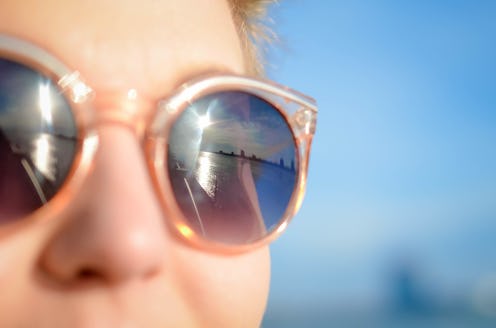Fashion
This Is The One Sunscreen Mistake Everyone Makes

When the summer sun comes out to play, we know that a good SPF is one of the most important products in our beauty arsenals. However, even if we make sure to always carry it with us to the beach, there's still one sunscreen mistake that pretty much everyone makes. And that's thinking that you don't need to apply it. Regardless if you know there are times when sunscreen is a must, most of us don't always treat it as an "every day" type of product. And we all have our reasons. Maybe we're just going for a walk — we won't be outside that long. Maybe it's cloudy outside or we're sitting in the shade. Maybe it's not the heat of the day yet, so the sun isn't close enough to burn. But even though we make excuses to ourselves, it doesn't stop the sun from doing its worst.
And as we know by now, the sun can do some serious damage. Without protection, it's so much easier for the sun to prematurely age your skin, causing wrinkles and dark spots — even if you're not getting sunburned. But forgoing sunscreen during sun exposure can also increase your risk of skin cancer, especially if you've been burned. And yes, "sun exposure" includes when it's cloudy, cold, lasts more than a few minutes, and even when you're in a car or in the shade — according to Dr. Jessica Weiser of New York Dermatology Group with whom I corresponded via email, UVA rays can penetrate glass and UVA/UVB rays can reflect off of water and light surfaces to still cause sun damage and increase your risk of skin cancer. So to prevent any and all of those negative side effects of not wearing sunscreen, make sure to sport the right SPF every time you'll be exposed to sunlight, whether directly or indirectly. To make sure you're reaping the optimal protection though, it's also important to not make any of these additional sunblock application mistakes.
1. Not Using Enough
According to Dr. Weiser, we're supposed to use one teaspoon of sunscreen to cover the face, and at least a shot-glass worth to cover all exposed skin surfaces every time we apply. But especially with those easier-to-use spray sunscreens, we tend to use much less than we should. Dr. Jeannette Graf, assistant clinical professor of dermatology at Mount Sinai Medical Center in New York, told Health.com that to make sure you're using the right amount of sunscreen when you opt for a spray, hold the canister six inches away, spray continuously, and rub it in even if the directions say it's not necessary.
2. Not Applying Prior To Sun Exposure
Many times we wait until we're already outside to apply our sunscreen, but this isn't the best practice. Dr. Weiser explains that those protective properties take at least 15 minutes to activate, so your skin is actually still vulnerable to sun damage right after you've applied. If you anticipate being outside, remember to apply your SPF 15 to 30 minutes before venturing out.
3. Applying After Getting Dressed
Part of waiting to apply until we're already outside often means we're also not applying until after we've already dressed. But when we have barriers like clothes that we may not want to contaminate with greasy sunscreen, we apply a little more delicately around those areas. I know you've done it. So it becomes easier for us to miss spots and leave them susceptible to sunburn. The best way to make sure you have an even sunscreen application is therefore to do it totally naked before you get ready to leave.
4. Forgetting Smaller Areas
I know applying sunscreen is annoying, but if you're going to do it anyway, you might as well be thorough about it. Dr. Weiser warns against forgetting those smaller and more-commonly neglected areas like the lips, ears, scalp (your part-line can easily be burned), back of the hands and fingers, feet, and even inside (or on top of) your bellybutton. Speaking from personal experience, a sore bellybutton is no fun.
5. Not Reapplying
And of course, don't forget to reapply. Dr. Weiser recommends reapplying every two hours if skin remains dry. She stresses that, "It is crucial to realize that sun protection applied in the morning is no longer active by lunchtime and needs to be reapplied for proper protection." If you're swimming or sweating? Make sure to read the label of your sunscreen to know if it provides 40 or 80 minutes of water resistance, and reapply accordingly.
After all, it's better to be safe than sorry isn't it?
Image: Sara Kauten/Unsplash